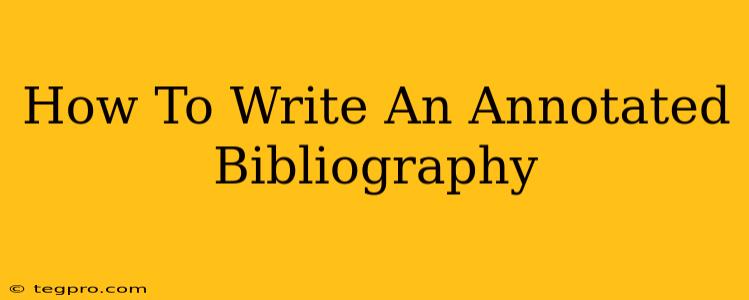Creating an annotated bibliography might seem daunting, but it's a valuable skill that demonstrates your research prowess and understanding of scholarly sources. This comprehensive guide will walk you through the process, from understanding the basics to mastering the nuances of crafting compelling annotations. We'll cover everything you need to know to write an annotated bibliography that impresses.
What is an Annotated Bibliography?
An annotated bibliography is more than just a list of sources; it's a powerful research tool. It's a list of citations to books, articles, and documents. Each citation is followed by a brief (usually about 150-200 words), descriptive and evaluative paragraph, the annotation. The annotation briefly summarizes the source and assesses its value, relevance, and credibility. Think of it as a mini-review for each source used in your research.
Key Components of an Annotated Bibliography Entry
Each entry in your annotated bibliography should consist of two main parts:
1. The Citation:
This follows a specific citation style (MLA, APA, Chicago, etc.). Consistency is crucial. Ensure your citation accurately reflects the source's publication information, including:
- Author(s): List authors in the order they appear on the publication.
- Title: Include the title of the book, article, or website.
- Publication Information: This includes the publisher, journal name, website URL, publication date, and page numbers (where applicable).
2. The Annotation:
This is where you provide a summary and evaluation of the source. A strong annotation typically includes:
- Summary: Briefly describe the main arguments, findings, or information presented in the source. What is the central thesis or purpose?
- Evaluation: Critically assess the source's credibility, methodology (if applicable), bias, and overall contribution to your research. Is the information reliable? What are the source's strengths and weaknesses? How does it relate to your research topic? Consider the author's expertise and potential biases.
- Relevance: Explain how the source supports your research. How does it contribute to your understanding of the topic? Clearly connect the source to your overall research goals.
Steps to Writing an Effective Annotated Bibliography:
-
Choose a Citation Style: Select a style guide (MLA, APA, Chicago, etc.) early on and stick to it consistently. Your institution or instructor will likely specify a preferred style.
-
Gather Your Sources: Compile all the relevant sources you plan to use for your research project.
-
Create Your Citations: Use a citation management tool (like Zotero or Mendeley) or carefully follow your chosen style guide to create accurate citations for each source.
-
Write Your Annotations: For each source, write a concise and informative annotation that summarizes, evaluates, and explains the relevance of the source to your research.
-
Review and Revise: Proofread your annotated bibliography carefully for accuracy, consistency, and clarity. Ensure that your annotations are well-written and effectively communicate your understanding of each source.
Examples of Annotation Types:
Annotations can vary depending on your assignment requirements. Some common types include:
- Informative Annotation: Summarizes the source's content without significant evaluation.
- Summative Annotation: Summarizes and evaluates the source, highlighting its strengths and weaknesses.
- Evaluative Annotation: Focuses primarily on evaluating the source's credibility, methodology, and contribution to the field.
Tips for Success:
- Be Concise: Aim for clear and focused annotations within the specified word limit. Avoid unnecessary detail.
- Use Your Own Words: Paraphrase the source's information; avoid excessive quoting.
- Maintain Consistency: Keep a consistent tone and style throughout your annotated bibliography.
- Proofread Carefully: Ensure that your citations and annotations are free of errors.
By following these steps and tips, you can craft a high-quality annotated bibliography that showcases your research skills and enhances the overall impact of your academic work. Remember, a well-crafted annotated bibliography is a testament to your diligent research and critical thinking abilities.

